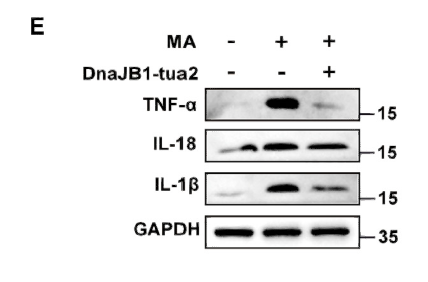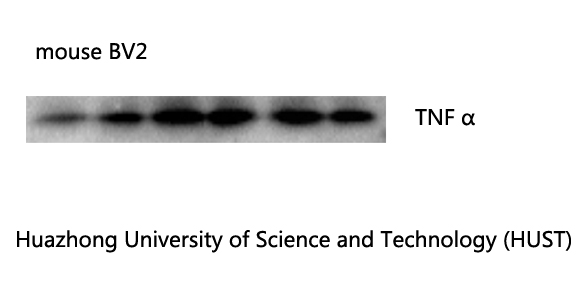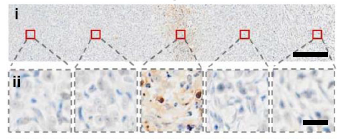TNF-α Monoclonal Antibody(Q34)
- Catalog No.:YM3477
- Applications:WB;IHC;IF
- Reactivity:Human;Rat;Mouse
- Target:
- TNFA
- Fields:
- >>Antifolate resistance;>>MAPK signaling pathway;>>Cytokine-cytokine receptor interaction;>>Viral protein interaction with cytokine and cytokine receptor;>>NF-kappa B signaling pathway;>>Sphingolipid signaling pathway;>>mTOR signaling pathway;>>Apoptosis;>>Necroptosis;>>TGF-beta signaling pathway;>>Osteoclast differentiation;>>Antigen processing and presentation;>>Toll-like receptor signaling pathway;>>NOD-like receptor signaling pathway;>>RIG-I-like receptor signaling pathway;>>C-type lectin receptor signaling pathway;>>Hematopoietic cell lineage;>>Natural killer cell mediated cytotoxicity;>>IL-17 signaling pathway;>>T cell receptor signaling pathway;>>Fc epsilon RI signaling pathway;>>TNF signaling pathway;>>Adipocytokine signaling pathway;>>Type II diabetes mellitus;>>Insulin resistance;>>Non-alcoholic fatty liver disease;>>AGE-RAGE signaling pathway in diabetic complications;>>Alcoholic liver disease;>>Type I diabetes mellitus;>>Alzheimer disease;>>Amyotrophic lateral sclerosis;>>P
- Gene Name:
- TNF TNFA TNFSF2
- Protein Name:
- Tumor necrosis factor (Cachectin) (TNF-alpha) (Tumor necrosis factor ligand superfamily member 2) (TNF-a) [Cleaved into: Tumor necrosis factor, membrane form (N-terminal fragment) (NTF); Intracellular
- Human Gene Id:
- 7124
- Human Swiss Prot No:
- P01375
- Mouse Swiss Prot No:
- P06804
- Rat Swiss Prot No:
- P16599
- Immunogen:
- Synthetic Peptide of TNF α
- Specificity:
- The antibody detects endogenous TNF α protein
- Formulation:
- Liquid in PBS containing 50% glycerol, 0.5% BSA and 0.02% sodium azide.
- Source:
- Monoclonal, Mouse
- Dilution:
- WB 1:1000-1:3000 IHC 1:50-1:200, IF 1:50-200
- Purification:
- The antibody was affinity-purified from mouse ascites by affinity-chromatography using epitope-specific immunogen.
- Concentration:
- 1 mg/ml
- Storage Stability:
- -15°C to -25°C/1 year(Do not lower than -25°C)
- Other Name:
- Tumor necrosis factor (Cachectin;TNF-alpha;Tumor necrosis factor ligand superfamily member 2;TNF-a) [Cleaved into: Tumor necrosis factor, membrane form (N-terminal fragment;NTF);Intracellular domain 1 (ICD1);Intracellular domain 2 (ICD2);C-domain 1;C-domain 2;Tumor necrosis factor, soluble form]
- Observed Band(KD):
- 17,25kD
- Background:
- This gene encodes a multifunctional proinflammatory cytokine that belongs to the tumor necrosis factor (TNF) superfamily. This cytokine is mainly secreted by macrophages. It can bind to, and thus functions through its receptors TNFRSF1A/TNFR1 and TNFRSF1B/TNFBR. This cytokine is involved in the regulation of a wide spectrum of biological processes including cell proliferation, differentiation, apoptosis, lipid metabolism, and coagulation. This cytokine has been implicated in a variety of diseases, including autoimmune diseases, insulin resistance, and cancer. Knockout studies in mice also suggested the neuroprotective function of this cytokine. [provided by RefSeq, Jul 2008],
- Function:
- disease:Cachexia accompanies a variety of diseases, including cancer and infection, and is characterized by general ill health and malnutrition.,disease:Genetic variations in TNF are associated with susceptibility to hepatitis B virus infection (HBV infection) [MIM:610424]. Approximately one third of all cases of cirrhosis and half of all cases of hepatocellular carcinoma can be attributed to chronic HBV infection. HBV infection may result in subclinical or asymptomatic infection, acute self-limited hepatitis, or fulminant hepatitis requiring liver transplantation.,disease:Genetic variations in TNF are associated with susceptibility to psoriatic arthritis [MIM:607507]. Psoriasis is a chronic inflammatory dermatosis that affects approximately 2% of the population. It is characterized by red, scaly skin lesions that are usually found on the scalp, elbows, and knees, and may be associated w
- Subcellular Location:
- Cell membrane ; Single-pass type II membrane protein .; [Tumor necrosis factor, membrane form]: Membrane; Single-pass type II membrane protein.; [Tumor necrosis factor, soluble form]: Secreted .; [C-domain 1]: Secreted.; [C-domain 2]: Secreted.
- Expression:
- Blood,Peripheral blood leukocyte,Placenta,Prostatic carcinoma,
Research on the correlation between activating transcription factor 3 expression in the human coronary artery and atherosclerotic plaque stability. BMC Cardiovascular Disorders Bmc Cardiovasc Disor. 2021 Dec;21(1):1-13 WB Human 1:100 Coronary
DEL-1 suppression attenuates atherosclerosis by modulating macrophagic GSK-3β/CEBP-β signaling pathway INTERNATIONAL JOURNAL OF CARDIOLOGY Bing Xia IHC Mouse,Human coronary arteries,aorta
A novel gene therapy for methamphetamine- induced cognitive disorder with a hyper-acidified fusion variant of DnaJB1 Molecular Therapy-Nucleic Acids Zhurong Zou WB Mouse hippocampus BV2 cell
Association of GAL-8 promoter methylation levels with coronary plaque inflammation INTERNATIONAL JOURNAL OF CARDIOLOGY Bing Xia IHC Human 1:100 coronary tissue
- June 19-2018
- WESTERN IMMUNOBLOTTING PROTOCOL
- June 19-2018
- IMMUNOHISTOCHEMISTRY-PARAFFIN PROTOCOL
- June 19-2018
- IMMUNOFLUORESCENCE PROTOCOL
- September 08-2020
- FLOW-CYTOMEYRT-PROTOCOL
- May 20-2022
- Cell-Based ELISA│解您多样本WB检测之困扰
- July 13-2018
- CELL-BASED-ELISA-PROTOCOL-FOR-ACETYL-PROTEIN
- July 13-2018
- CELL-BASED-ELISA-PROTOCOL-FOR-PHOSPHO-PROTEIN
- July 13-2018
- Antibody-FAQs
- Products Images

- A novel gene therapy for methamphetamine- induced cognitive disorder with a hyper-acidified fusion variant of DnaJB1 Molecular Therapy-Nucleic Acids Zhurong Zou WB Mouse hippocampus BV2 cell

- Western blot analysis of Recombinant Human TNF a Protein with TNF α Mouse mAb at 1:2,000.

- Immunohistochemical analysis of paraffin-embedded Human Tonsil Tissue using TNF aMouse mAb diluted at 1:50

- The picture was kindly provided by our customer

- A novel gene therapy for methamphetamine- induced cognitive disorder with a hyper-acidified fusion variant of DnaJB1 Molecular Therapy-Nucleic Acids Zhurong Zou WB Mouse hippocampus BV2 cell

